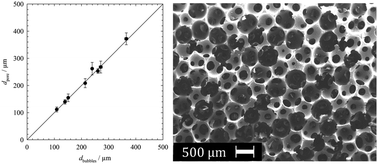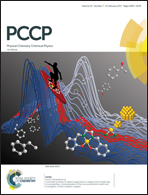Monodisperse polystyrene foams via polymerization of foamed emulsions: structure and mechanical properties†
Abstract
Foamed styrene-in-water emulsions can serve as templates for solid polystyrene foams as the pore size dpore in the solid polystyrene foam matches the bubble size dbubble of the liquid foam template. By producing monodisperse foamed emulsions with a microfluidic device it is possible to adjust the pore size, the connectivity of the pores, as well as the density of the solid polystyrene foams. The pore size can be tuned either by varying the gas pressure used to form the emulsion or by varying the chip dimension. Using three different chip dimensions we are able to produce monodisperse polystyrene foams with pore sizes ranging from 115 μm up to 588 μm. The relative density can be varied easily in a range from 0.10 to 0.30. Increasing the liquid fraction leads initially to smaller interconnections and ultimately to a mainly closed cell foam. It is practically impossible to produce a fully closed cell foam since, even at high liquid fractions, two adjacent bubbles eventually touch and form a film that will rupture during polymerization. By closely investigating the structure of the polystyrene foams we noticed an additional porosity in the pore walls which matches the water content of the styrene-in-water emulsion. During polymerization, the styrene droplets in the aqueous matrix fuse and build up a continuous but porous structure which makes up the pore walls of the macropores. This additionally porosity also leads to lower Young's and shear moduli than expected, as predicted by Gibson and Ashby's model. The relationship between relative density and moduli is in good agreement with the model.



 Please wait while we load your content...
Please wait while we load your content...